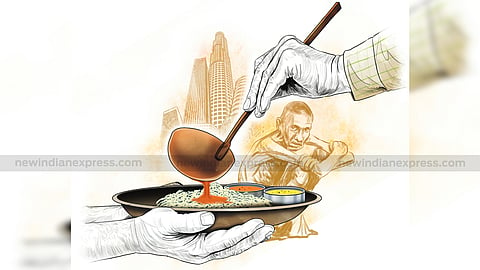

The government's statistical release last Saturday offers some celebratory cheer.
The long-awaited Household Consumption Expenditure Survey 2022-23, emerging through the space-time tear eleven years too late, hints at a substantial decline in India's poverty rate.
There's no official word yet, but given that consumption expenditure surveys are often used to determine the income-based poverty line, independent forecasts hazard the actual rate to be plenty handsome.
For now, the estimates overloading the statistical circuitry range between 2% and 5%. It means, the number of poor people in India are somewhere between 2.8 crore to about 7 crore. The last official poverty estimate in 2011 counted 26 crore, or 21.9% of the population, as extremely poor. And if the latest consumption survey findings indeed confirm that poverty rates fell from double-digits to low single digits, it'll be a remarkable feat. Moreover, if -- as some economists project -- extreme poverty has vanished, it'll be showcased as the richest prizefight in the forthcoming 2024 electoral battle.
But seasoned observers argue the case for adopting a higher poverty line. Currently, we use the Tendulkar poverty threshold, where a person living on a monthly expenditure of Rs 1,000 per month or Rs 33 or less per day in cities, and Rs 816 per month or Rs 27 or less per day in villages is considered poor. Adjusted for purchasing power parity rates, it falls closer to the World Bank's extreme poverty measure of $2.15 per person per day (earlier $1.90).
For long, the Tendulkar estimate has been considered low for a growing economy like India, and hence the government formed another expert group led by Dr C Rangarajan to relook. Subsequently in 2014, the Rangarajan Committee suggested a slightly higher monthly threshold of Rs 1,407 (Rs 47 per day) for urban areas and Rs 972 (Rs 33 per day) for rural areas. But this wasn't accepted and so we continue to live with the Tendulkar poverty line adopted way back in 2009.
Now, the chorus for increasing the poverty line is growing louder with the economy growing steadily. The latest consumption expenditure survey too further confirms the changing expenditure patterns of households reinforcing the need to move away from the existing extreme poverty line of $2.15 per person per day to the lower-middle income poverty line of $3.65.
In fact, just before the pandemic, a 2020 IMF working paper by economists Dr Surjit Bhalla, Karan Bhasin and Arvind Virmani noted that poverty decreased and just about 2.5% of the population were below extreme poverty during 2019-2020. They sought an increase in the threshold to World Bank's $3.2 (now $3.65), where an estimated 26.5% of Indians were living. And for the first time in Indian statistical history, the paper incorporated the effect of fiscal interventions like cash and in-kind transfers and subsidies and found that only 0.9% of Indians were extremely poor, living on less than $1.9 per person per day, and 18.2% were poor living on $3.2 per day in 2020.
Later, the pandemic struck, pushing all those living on the breadline back into extreme poverty. Though income losses were partly offset by subsidies and cash transfers, it's undeniable that household incomes and expenditures suffered badly. Amid concerns that poverty rates may have plunged unfathomable depths, Bhalla's subsequent IMF working paper in 2022 shows that extreme poverty stood below or equal to 1% during the pandemic years, thanks to government interventions.
In contrast, the World Bank's most recent estimate (released in 2022) puts India's poverty rate at 11.9% during the pandemic year 2021. Other private estimates too share similar higher rates. One of the reasons for these wide ranging estimates is the difference in survey methodologies and the recall periods, or the duration of time over which the survey respondents are asked to list their expenditures.
Traditionally, poverty rates are measured using household consumption expenditure surveys. But there are alternate methods like imputing the growth rate in national accounts consumption to the mean to derive poverty levels. As for household surveys, there are three prominent methods.
The first, but now obsolete, is the Uniform Reference Period (URP), where survey respondents recall their expenditures incurred during the previous 30 days. Then there's Mixed Reference Period (MRP) that includes respondents to recall low-frequency expenditures like buying clothes, durables, education over the past one year, besides a 30-day expenditure recall on other purchases. Lastly, there's Modified Mixed Reference Period (MMRP) to list less frequent expenditure over a 365-day period, a 30-day period on items like fuel and light, rent and taxes and a 7-day period on perishables like vegetables and fruits.
Prior to the 1983 consumer expenditure surveys, consumption data in India was collected using the URP method, i.e., asking respondents about their expenditure in the previous 30 days. In 1983, we switched to MRP, where households were asked about their expenditures on three items over a 365-day period, along with a 30-day recall for other expenses. In 1993-94, the MRP method was broadened to include five major, but low-frequency consumption items like clothing and bedding, footwear, institutional medicine, education and durable goods, along with the 30-day recall of other expenses.
Lastly, around 1999-2000, purchases of perishables like vegetables and fruits began with a 7-day recall period began -- the MMRP method. This is now our official method of measuring poverty. Even the World Bank endorses MMRP and has been urging countries to adopt it. Ironically though, the multilateral bank continues to use the outdated URP to estimate poverty in India and neither adjusts food subsidies and transfers, which explains the difference in poverty estimates.
Interestingly, the latest consumption expenditure survey, for the first time, calculated the imputed value of subsidies and transfers to capture the effect of fiscal interventions. While these measures seem to have cushioned the adverse affect of pandemic-induced income losses, the fact remains that the overall household expenditures over the past one decade remained low, turning in a CAGR of just 3%-3.5% for both urban and rural areas, respectively.